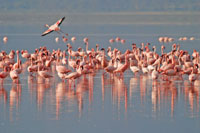Tanzania targets tourists from Middle East

Kenya’s visitor arrival numbers passed the two million mark in 2007 according to managing director of the Kenya Tourist Board, Achieng Ongong.
However, the recent election crisis has severely impacted tourism development, and in the first quarter of 2008 the cancellation of flights to the country could translate into a drop of more than 90 per cent in international arrivals, according to a report issued at ITB in March.
“Sadly all of Kenya has been affected, including our properties, by election aftermath,” said Nancy Shaw from Fairmont. “Things are calm and striving to go back to normal, however the economy and tourism has suffered a blow to which it will take many months to recover.”
Africa Connection, a travel and tourism company based in Dubai, found that all its suppliers had been affected by the situation in Kenya.
“Although the year started on a traumatic note, with substantial loss of business in January and February, bookings for July and August have remained. New queries are now being received, and on the whole, there is a feeling of optimism that tourism will return to the same level,” said Judy Fell, managing director.
“All our suppliers have indicated, without exception, that the safari areas have remained quiet and well away from the turmoil.”
Clients that booked for Kenya over the New Year period cancelled until further notice, but since then, the new bookings they have received for East Africa have been for Tanzania.
“Our main destinations in East Africa are Kenya, Tanzania and Zanzibar, with some interest in Uganda and Rwanda,” said Fell.
Dina Al Herais, vice president, Commercial Operations, Emirates Holidays said, “Emirates Holidays will reinstate sales once we are comfortable that the situation has stabilised. In the interim, customers who have booked an Emirates Holidays package to Kenya, have the opportunity to cancel without any charges, change their destination or rebook to travel at a later time.”
Emirates Holidays features Kenya, Tanzania and Zanzibar packages which are popular with expatriates and couples, and the region is becoming more and more popular among holidaymakers. “The wildlife is the main attraction, especially the annual migration,” she said.
Tanzania’s visitor numbers had not increased specifically since the election crisis as the two countries offer travel packages that include both destinations, according to Amant Macha, director of marketing, Tanzania Tourist Board.
Tanzania is starting an aggressive marketing campaign, which started off with national TV campaigns in the USA and a travel agent training course over there, says Macha. They will also target the Middle East, already well connected with daily flights from Dar es Salaam to Doha and Dubai. Air Tanzania is also planning to operate a route to Dubai “towards the end of the year,” said Macha.
Some safari camps help each other out in times of crisis, such as at Robin Pope Safaris, who offered Kenya destined travellers alternatives to camps in southern Africa. “When we had the big floods in Zambia last February our clients were sent to other camps in Kenya,” said Conor Crowley, sales and marketing manager, Robin Pope Safaris. “At that time we were also in the position of having to cancel or postpone holidays, and some travel insurance policies may not have paid out for cancellations, so it was a relief to relocate our guests to neighbouring countries.”
This time round it was the Kenyan safari camps under stress. “We don’t exploit the plight of our neighbours for our benefit – it is rather more a reciprocal approach. We offer tourists an alternative.”
Nathan Adams, product development manager, Dnata Holidays, has experienced a big upturn in holiday bookings from Middle Eastern guests to Seychelles and Mauritius.
In Uganda, visitor numbers to the north and eastern national parks have slowly increased as security fears wane, according to the Travel Business Partnership. It quotes the Ugandan Wildlife Authority as saying that the number of tourists who visited Murchison Falls National Park, the country’s largest protected national park, increased from 2,741 in 2006 to 3,451 in 2007.
On the other hand, visitors to Queen Elizabeth National Park set in the shadow of the Rwenzori Mountains, the Bwindi Impenetrable National Park famous for its gorilla tracking and Lake Mburo National Park centred on swamp fringed lakes reduced overall from 10,170 during the December 2006 tourist season to 9,464 in 2007.
Conservation efforts continue to help the endangered mountain gorillas of the eastern Congo, Uganda and Rwanda, for whom a 10 year programme between the three countries has been drawn up to prevent poaching and illegal tree cutting. The Dutch government is providing the initial fund of $6.4million for the scheme through the International Gorilla Conservation Programme.
The East African Community (EAC), the regional intergovernmental organisation of Kenya, Uganda, Tanzania, Burundi and Rwanda with its headquarters in Arusha, Tanzania, is apparently moving closer towards marketing the region’s tourism as a single bloc, and responsibility for this will lie with the East African Tourism and Wildlife Coordination Agency (EATWCA) due for launch this year.
